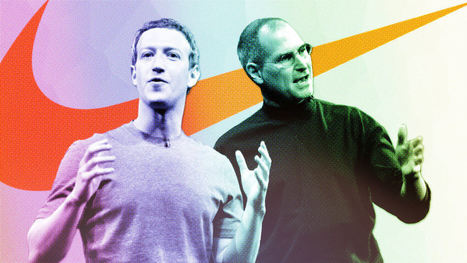 Your new post is loading...
 Your new post is loading...
In his 2018 annual letter, Amazon founder and CEO Jeff Bezos repeated his rule that PowerPoint is banned in executive meetings. What Bezos replaced it with provides even more valuable insight for entrepreneurs and leaders. In his letter, and in a recent discussion at the Forum on Leadership at the Bush Center, Bezos revealed that "narrative structure" is more effective than PowerPoint. According to Bezos, new executives are in for a culture shock in their first Amazon meetings. Instead of reading bullet points on a PowerPoint slide, everyone sits silently for about 30 minutes to read a "six-page memo that's narratively structured with real sentences, topic sentences, verbs, and nouns." After everyone's done reading, they discuss the topic. "It's so much better than the typical PowerPoint presentation for so many reasons," Bezos added.
Via The Learning Factor
It’s that time of year when many of us get motivated to make ourselves better—healthier, wealthier, wiser, or just different—in the new year. Roughly six in 10 of us make New Year’s resolutions, according to a 2016 Harris poll. But following through on those goals isn’t easy. Roughly half of those who are earnestly vowing to make improvements in 2018 are likely dusting off the same list they had last year. So if you want to actually accomplish those goals—or at least make a dent in them—by this time next year, use these five approaches.
Via The Learning Factor
If you’re always working for the weekend, you’re not alone. Just one-third of employees are actively engaged at work, leaving the majority of us unhappy on the job, according to the most recent State of the American Workplace Gallup poll. Instead of keeping an eye on the clock and the calendar, take the reins by creating a career that you love, experts suggest. “People often find themselves on a lifelong career journey without a destination in mind, only to look back at some point and realize they are not where they expected or wanted to be professionally,” says Tom Kemp, MBA executive-in-residence at the University of Richmond’s Robins School of Business. “Often this reflection happens when they either find themselves confronted with a job loss or they simply become so disenfranchised that they quit with little idea or thought about what they want to do next.”
Via The Learning Factor
It happens to high- and low-performing teams alike: The ties that bind everyone together just aren’t as strong as they could be. Maybe you’ve inherited a team that’s always been sluggish and uninspired, or one that’s usually steady, but the trust is eroding under pressure. Or perhaps you’re just trying to take your team to the next level. Whatever the case, every team needs to reflect once in a while on what could be improved. It’s human nature to be conflict-averse, but it’s every manager’s job to bring points of conflict out into the open and move forward together. Unfortunately, most meetings aren’t the best venues for doing that. Typical team meetings focus on planning what’s ahead–an upcoming project, the next quarter’s top goals and metrics, expectations moving forward. But there’s a simple alternative, focused on reviewing the immediate past, that can change how your team works for the better.
Via The Learning Factor
Leadership challenges are more complex today than ever before, and one leadership challenge that I see as an executive coach is the tendency to anticipate what might happen tomorrow while forgetting about what is happening today. In other words, leaders try to outthink and overanalyze the future. They anticipate all the possibilities that could happen, select the outcome most likely to occur and then mold their leadership style to accommodate it, only to find that Murphy has a full-time job and is apparently dedicated solely to them — and Murphy wins.The point is, tomorrow, next week or next year are all uncertain, so if you try to mold your leadership style to the “most likely” option to occur, then you’re not leading, you’re contingency planning. Leaders don’t just think about the future, they think in it. Once they have a clear picture of what they want to see, where they want to be—as an individual or as a team — and why, they begin to mold the world around them to achieve it.
Via The Learning Factor
We might spend days, months, or even years trying to figure someone out. Is he who he says he is? Should I trust her? The wheels in our head spin as we think of all the variables and how they'll play out. And still, we keep hearing that we should just listen to our instincts. Complicated questions, simple answer. What should we do, and where did this whole idea of the gut instinct come from, anyway? Intuition isn't some magical, mysterious quality that we carry with us. It actually comes from the knowledge and past experiences that we all carry. Even if we're unable to explain why we feel the way we do, there's a logical explanation behind our gut feelings. Whenever you encounter anything new, the unconscious side of your brain is constantly making assessments. It takes in certain cues, such as a smile or parts of a story, and then matches it with something similar in our database of memories to come up with a conclusion. Meanwhile, our conscious side remains unaware of this rapid process taking place.
Via The Learning Factor
Nearly 70 percent of CEOs now recognize culture as one of the greatest sources of competitive advantage. Whereas company processes, technology, and strategy can be copied, an organization's DNA cannot be reproduced. With this realization, many organizations are turning to cultural change to fuel future growth and performance. Kaiser Associates, a business strategy and consulting firm, defines a high-performing culture as an organization that performs better than its peers in regards to business performance, innovation, employee productivity, and engagement, over a sustained period of time. For now, let's focus on how companies can leverage performance management best practices to build a winning culture.
Via The Learning Factor
Defined hierarchy. Commanding leadership. These corporate ligaments secure firms in the face of threats and unify them against competition. Few beliefs are more widely held in business. The intuition, though, is wrong. “When you look at real organizations, having a clear hierarchy within your firm actually makes people turn on each other when they face an outside threat,” says Lindred Greer, a professor of organizational behavior at Stanford Graduate School of Business. Effective teamwork against threats requires not hierarchy, but egalitarianism; not centralized power, but a culture in which all voices count. Along with Lisanne van Bunderen of the University of Amsterdam and Daan Van Knippenberg of Drexel University, the research team teased out this finding through two complementary studies. In the first study, an experiment, teams of three students developed and pitched a consultancy project to a prospective client. Some of these teams were non-hierarchical, while members of other teams arbitrarily received titles: senior consultant, consultant, junior consultant. Likewise, some teams faced no rivals, while others were told they were competing with a rival firm for clients. The researchers found that the subset of hierarchical teams facing competition with rival firms struggled with infighting while the egalitarian teams cooperated on their work.
Via The Learning Factor
To effectively lead and motivate employees, you don’t need charisma and a grand vision. Research from Michigan State University (MSU) found that being a successful boss was more about mind over matter. The study, published in the journal Organizational Behavior and Human Decision Processes, found that a leader’s focus, or mind-set, affects his or her own behavior, which in turn affects employees’ motivation. And the good news is that your mind-set can be changed to produce certain outcomes from workers, from creativity to loss prevention. “Effective leadership may be based in part on a leader’s ability to recognize when a particular mental state is needed in their employees and to adapt their own mental state and their behaviors to elicit that mind-set,” says Brent Scott, MSU professor of management and study coauthor. “Part of the story here is that you don’t have to be Steve Jobs to be an effective leader. There is no one-size-fits-all approach to managing.”
Via The Learning Factor
We all know that the work landscape is changing. The jobs that will be in demand are shifting as more are automated by artificial intelligence, machine learning, and robots. Teams are becoming more disparate and globalization has added new collaboration challenges. At the same time, more millennials are taking on management roles, and even our work spaces will undergo changes between now and 2025. “Change will be happening so quickly that 50% of the occupations that exist today will not exist 10 years from now. So we’re going to be living in an environment that is extremely adaptable and changing all the time,” says Liz Bentley, the founder of Liz Bentley Associates, a leadership development consulting firm.
Via The Learning Factor
You don’t need to be told why it matters to be transparent and honest at work–that much is a given. So is the overall usefulness of expressing yourself clearly, confidently, and with as few filler words as possible. But in the effort to do that, many of us fall back on common expressions that might sound totally fine in social situations but can do some quiet damage in the workplace. One of them is “I’m sorry.” Another is “to be honest.” The latter turn of phrase–and versions of it, like “honestly,” “frankly,” “if I can be honest with you,” or “let me be frank”–is easy to resort to when you want to cut through the crap, come clean, or offer your unvarnished opinion. But these expressions also tend to attach themselves to–and subtly encourage–certain messages that are either better left unsaid or ought to be rephrased. Here are times when “to be honest” can make you sound less authoritative around the office.
Via The Learning Factor
One in four American adults went to a healthcare provider for neck and back pain, according to a 2016 Gallup study. In addition, the report found 65% of adults sought care for neck and back pain at some point in their lives. When you factor in how many adults are hunched over computer desks, sitting for extended periods of time at work and bending their neck to read mobile devices, these statistics aren’t so surprising. Just about everyone has been told to “stand up straight” at some point in their lives—and it turns out that mom was right. Posture is a key element to good health. It is right up there with eating healthy, getting enough sleep and exercising. Bad posture can lead to back, neck and jaw pain, breathing difficulty, balance issues and joint problems. A recent study also found that good posture can improve your mental wellbeing.
Via The Learning Factor
Research has shown that when we receive an email, we’re predisposed to view the tone of that message negatively–or at least more negatively than the sender intended it. Given that everyone has this natural “negativity bias” against email, it’s important to pay close attention to your phrasing. For the most part, we use email either to remind people about things they said they’d do, or to ask them to do something for us. In the absence of social cues, this is a delicate task. With that in mind, here are a few tips for making your emails friendly and appealing—without running on too long or coming off as ingratiating.
Via The Learning Factor
|
You’ve probably been taught that giving compliments build relationships. In the self-help classic How to Win Friends and Influence People, Dale Carnegie stressed the importance of “giving sincere and honest appreciation” to others in life and work. He’s not wrong, but the thing is that showing real appreciation is difficult to do. How many times has someone given you a “compliment” and you just know they’re trying to get something from you? Compliments can easily veer into flattery and feel insincere, leaving the recipient wondering about the giver’s hidden agenda. Here’s what it takes to avoid all that–it’s easier than you think.
Via The Learning Factor
According to an Oxford University analysis, close to half of all jobs will be taken over by robots in the next 25 years. No wonder the press is full of handwringing about how workers will adjust and the best way to prepare the next generation for this A.I.-filled future. But not everyone is alarmed about the prospect of radical change in the labor market. After all, this has happened before (for instance, when mechanization replaced the vast majority of farmers) and it turned out OK. Plus, a lot of today's jobs are soul-crushingly boring and repetitive. Losing them just might be a blessing. Among these optimists are IT service company Cognizant. In a recent report (hat tip to Business Insider for the pointer), the consultancy notes that while creative destruction has always been with us, so has reinvention. Sure, robots will take jobs away, but they'll also create new ones. What will these new gigs look like exactly? The report imagines detailed job ads for 21 future careers that Cognizant thinks may emerge in the next 10 years.
Via The Learning Factor
Let’s not waste any time. The simple solution that we’re all looking for: It doesn’t exist. Want your business to thrive like Amazon’s? Want to emulate Steve Jobs or Mark Zuckerberg? Follow the road map of Nike or Warby Parker to build the next brand that matters? Sorry, it doesn’t work that way. What succeeded for them may not work for you. Too bad. Get over it. One-size-fits-all strategies just aren’t effective in today’s age of flux (and maybe they never were). That’s one of the insightful messages in senior writer Austin Carr’s feature The Future of Retail in the Age of Amazon. It’s become common practice to refer to billion-dollar startups as “unicorns,” but there is no more one-of-a-kind business than Amazon: hard-driving, customer-focused, yet broadly directed, from books and groceries to entertainment, consumer electronics, and web services. Carr explains that competing with Amazon today–trying to beat it at its own game–is largely a fool’s errand. Instead, what increasingly defines retail success, and points the way toward the businesses of tomorrow, is a bespoke model, one that is crafted to deliver on a focused need, proposition, or brand essence.
Via The Learning Factor
Companies want to be profitable and maximize their performance and impact both in the world and within their industry. With that said, accomplishing those feats starts with cultivating a culture to allow those things to happen which starts with a priority on employee well-being. Culture is important -- it affects engagement, mindset, reputation, recruitment of talent, and well being. When looking to cultivate a healthy and high performing culture, start by emphasizing these six points:
Via The Learning Factor
Some people just seem to bounce back from whatever life throws at them. Whether it’s illness, loss, or tragedy, they do the tough work of picking themselves up, dusting themselves off, and carrying on—even when it seems impossible. If you’ve ever thought, “I could never do that” when looking at one of these apparent “superheroes,” don’t be so sure. It’s actually possible to build resilience to make yourself better able to bounce back from even the most difficult times. “It’s the ability to get back in the game after you’ve had some sort of failure. And indeed, we can learn to become more resilient,” says social scientist and leadership expert Frank Niles, PhD. Niles says there are a number of science-backed areas people can address to help them be more resilient. Here are some ways you can shore up your “resilience bunker” to better prepare for when tough times strike.
Via The Learning Factor
From a wealth of real-world examples such as Warren Buffett and Bill Gates to a ton of science and expert opinion, there's no shortage of evidence that introverts can make great leaders. But, of course, quieter types can only demonstrate this fact if they decide to step up to the plate and lead. And according to new research, many introverts may be shying away from leadership positions in which they'd actually excel, because of misplaced fears about their potential and capabilities.
Via The Learning Factor
Are you a micromanager? You will probably say no. Maybe you self-deprecatingly call yourself a “control freak.” Or just “hands-on.” You just “care too much.” And it’s true: You do feel a certain need for a sense of control over your work. You are responsible, after all–perhaps more responsible than some of your coworkers or direct reports. You’re afraid of mistakes and believe that if something needs to be done well, you’d better do it yourself. But this isn’t just because you’re an “independent self-starter” who holds their work to a high standard. It might be that, too, but it’s probably also because you’re feeling stressed.
Via The Learning Factor
Getting smart people into your company is hard enough. Turning them all into great collaborators and risk-takers is even harder. Even on the most high-performing teams, coworkers don’t just openly share feedback and challenge each others’ ideas all on their own–managers need to create a culture that encourages this. And that usually requires building your team’s collective emotional intelligence. Here are a few straightforward (and entirely low-tech ways) to get started.
Via The Learning Factor
Millennials are starting to take control in the workplace. There are now more than 75 million millennials in the workforce, more than baby boomers (just shy of 75 million) and Gen Xers (66 million). Now entering their late 20s and early 30s, the oldest members of the generation are starting to take more leadership positions in major organizations. Despite the fact that millennials are sporting one of the lowest rates of entrepreneurship in 25 years, 60% see themselves as entrepreneurs, and 90% recognize entrepreneurship as a mindset. Combined with their natural tendencies toward independent thought and mild to moderate anti-establishment vibes, this is making millennials a strong force of direction and leadership—and an even stronger one to come in the next several years.
Via The Learning Factor
First-time managers often ask themselves how to develop a leadership style that suits them: “Who should I model myself after? What kind of leader should I be?” It’s great to think critically about your approach to managing others, particularly when you’re new to it, but these questions won’t exactly help you. That’s because they assume that leadership is something you try on and show off, a “style” that’s curated and intentional. But especially in the beginning, your style will be based far less on mirroring others’ habits and behaviors and far more on instinct and intuition. And that’s not necessarily a bad thing.
Via The Learning Factor
Tell someone 'I'm sick' or 'I'm tired' and you're not really giving them much information. How sick? How tired? Do you have a mild cold or a dread disease? Are you a new parent who hasn't slept in months or did you just enjoy the party last night a little too much? Burnout is the same. It comes in different degrees, from your common 'I can't wait for happy hour' variety, to far more serious 'I need to take a six-month sabbatical and re-evaluate my life' burnout. The appropriate response for different stages is very different. So how do you know how burnt out you are exactly? Science, apparently, can help. Recently 99U's Hamza Khan dug up a classic Scientific American article (subscription required) that describes a 12-stage model of burnout developed by psychologists Herbert Freudenberger and Gail North. Here are the stages the scientists outline:
Via The Learning Factor
LinkedIn, once your online resume, has morphed into your opportunity to introduce yourself to others and attract the attention of those who need to know you. However, mindsets are slow to shift, and those who still consider LinkedIn nothing more than a digital resume are missing out on some of the biggest opportunities LinkedIn has ever offered. In a world that is becoming more virtual, with remote work becoming the norm, LinkedIn often delivers your first impression. To make sure you come across as the wildly interesting, compelling, and accomplished person you are, focus on the following six elements of your profile.
Via The Learning Factor
|



 Your new post is loading...
Your new post is loading...













































A very interesting insight into the mind of one of the richest men in the world. Slightly different thinking and a willingness to take a different approach is what separates those who are successful from those who aren't.